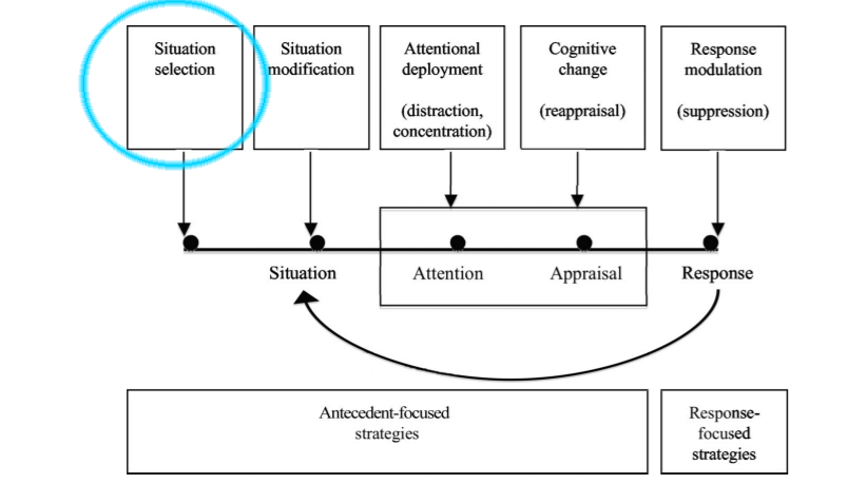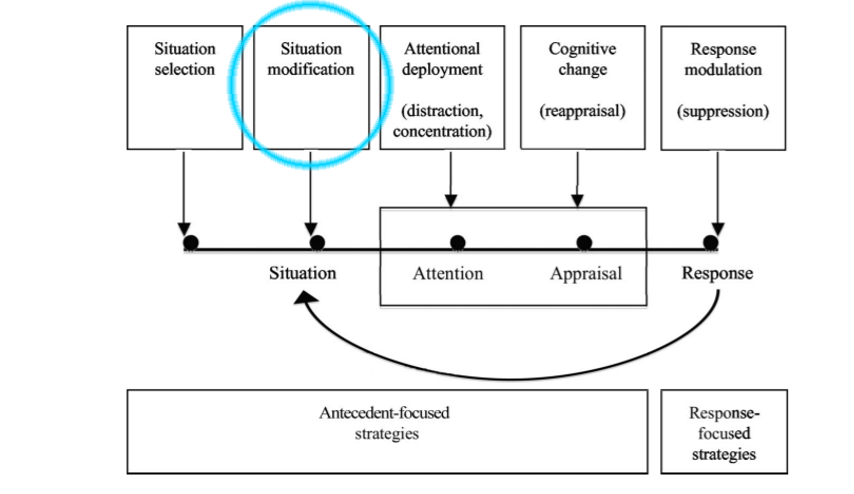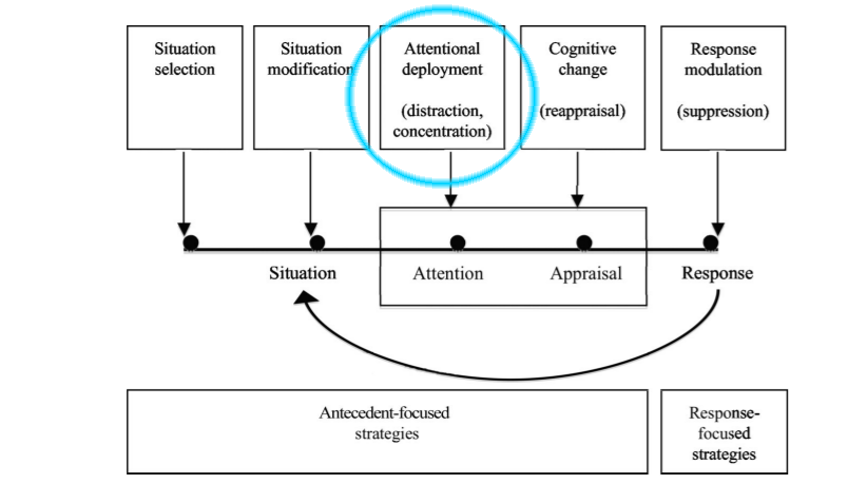Chapter 14 – Emotion Regulation
Antecedent-Focused Emotion Regulation
Antecedent-focused emotion regulation occurs before or during the emotion experience. Antecedent-focused strategies occur when we alter the eliciting event (situation selection, situation modification) or when we alter our cognitions (attention deployment, cognitive change). Situation selection is the strategy that occurs earliest in the emotion experience, whereas cognitive change occurs later in the emotion experience. Below, we will discuss each strategy in turn.
Situation Selection

Long Description
A flowchart depicting strategies for emotion regulation. It consists of five rectangular boxes aligned horizontally at the top, each representing different strategies: “Situation selection,” “Situation modification,” “Attentional deployment (distraction, concentration),” “Cognitive change (reappraisal),” and “Response modulation (suppression).” The first box, “Situation selection,” is highlighted with a light blue circle. Below these boxes, an arrow points downward to a horizontal line labeled with three stages: “Situation,” “Attention,” and “Appraisal,” which connect to a “Response.” Curved arrows indicate feedback loops between these stages. The lower part of the image is divided into two sections labeled “Antecedent-focused strategies” and “Response-focused strategies,” with the former encompassing the first four strategies and the latter linked to “Response modulation.”
During situation selection, we choose between two or more situations; we seek out, avoid, or change situations based on the emotions we desire to have and/or the emotions we do not want to have. When we engage in situation selection, we are predicting the emotions we will experience in a variety of situations and making a decision about which situations to enter or avoid based on our prediction of our emotions. How do we predict our emotions? We might recall how we felt in a similar situation or look to others’ emotional experiences in the same situation. Keep in mind that we enter into many situations without predicting our emotions. For example, going to class or going to a doctor’s appointment would not be considered situation selection because we are NOT entering those situations with the goal to elicit a certain emotion.
Situation Modification

Long Description
The image is a flowchart illustrating the process of emotion regulation. It consists of five main rectangular boxes arranged horizontally, each representing a stage in the process. From left to right, these are titled: “Situation selection,” “Situation modification,” “Attentional deployment (distraction, concentration),” “Cognitive change (reappraisal),” and “Response modulation (suppression).” Each box is connected with downward arrows to a horizontal line that runs beneath them. Below this line are three smaller boxes labeled “Situation,” “Attention,” and “Appraisal,” with a final destination titled “Response” at the end of the line. An arrow loops back from “Response” to “Situation,” indicating a cyclic nature. Additionally, “Situation modification” is highlighted with a blue circle. Two overarching labels at the bottom further distinguish between “Antecedent-focused strategies” and “Response-focused strategies.”
Once a situation is selected, the situation can be modified to alter the emotional impact. Situation modification occurs when people are already experiencing an event but try to change aspects of the external environment to alter their emotional experience. For example, you might be nervous about giving a speech in class, so you ask your friends to sit in the front row so you can look at them. Gross (2008) points out that there may not be a clear delineation between situation selection and situation modification. This is because altering the situation could cause us to enter a new situation – essentially causing situation selection!
Attention Deployment

Long Description
The image is a flowchart illustrating the process of emotion regulation strategies. It is structured in linear sections from left to right and includes five rectangular components: “Situation selection,” “Situation modification,” “Attentional deployment (distraction, concentration),” “Cognitive change (reappraisal),” and “Response modulation (suppression).” Each rectangle is connected by arrows showing the flow of the process from “Situation” to “Attention,” then “Appraisal,” and finally “Response.” Underneath, a horizontal line segments the process into “Antecedent-focused strategies” and “Response-focused strategies,” with arrows indicating the strategies’ influence. “Attentional deployment” is highlighted with a blue circle.
- Physical withdrawal of attention: This occurs when people remove their attention on the external environment. For example, by covering our eyes during a scary movie or covering our ears when a fire truck drives by.
- Distraction (sometimes called redirection) “focuses attention on different aspects of the situation or moves attention away from the situation altogether” and “may also involve changing internal focus, such as when individuals invoke thoughts or memories that are inconsistent with the undesirable emotional state” (Gross & Thompson, 2007, p. 13). In addition, distraction could be positive or neutral (Webb, 2012). Positive distraction occurs when we shift our attention to something positive, whereas neutral distraction occurs when we shift our attention to a neutral aspect. Gross (2008) divides distraction into internal and external redirection.
- Internal redirection of attention or internal distraction: This occurs when someone tries to change their focus themselves. They could achieve this redirection in two ways. First, by shifting their focus to a different aspect of the situation, such as when having blood drawn move their attention from the needle to a pleasant piece of artwork hanging on the wall. A second way would be by shifting their focus to their own internal thoughts and emotion. For example, when someone is having their blood drawn, they might try to focus their attention away from the needle and pain to thoughts of an upcoming vacation. In the literature, these techniques are often called distraction. Internal distraction could be positive or neutral.
- External redirection of attention or external distraction: This occurs when someone or something else in the external situation tries to redirect our attention. For instance, when a child is hitting their sibling, a parent might try to direct their attention away from the sibling and to a toy. Similar to above, external distraction could be positive or neutral.
- Concentration refers to emotion regulation strategies that “draw attention to [the] emotional features of a situation” (Gross & Thompson, 2007, p. 13). Sometimes this strategy is called confrontation, especially in a therapeutic context. Researchers divide concentration into three categories (Ward et al., 2012): 1) experiential, 2) analytical, and 3) a combination of experiential and analytical.
- Experiential processing occurs when people concentrate on their feelings and “experiences” regarding the emotion experience.
- Conceptual-evaluative or Analytical Processing occurs when people concentrate on the causes, meanings, and outcomes of the emotional event. In the literature, this type of processing is called problem-focused coping. Rumination is a type of concentration during which experiential processing occurs. Rumination occurs when we focus our attention inward to consciously think about to our feelings and thoughts about an emotional experience. With rumination, we are essentially reliving the prior emotional experience, similar to a recurring emotion episode. For example, when we continue to think about a breakup, we experienced then night before.

